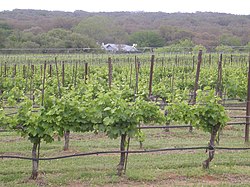Texas wine
Texas has a long history of wine production. The sunny and dry climate of the major wine making regions in the state have drawn comparison to Portuguese wines. Some of the earliest recorded Texas wines were produced by Spanish missionaries in the 1650s near El Paso. The state is home to over 36 members of the Vitis grape vine family with fifteen being native to the state, more than any other region on earth. As of 2006, the state had over 3,200 acres (1,300 ha) planted with Vitis vinifera. Despite being the largest of conterminous states, this relatively small amount of planted land is dwarfed by the production of even the smallest French AOCs like Sancerre. The Texan wine industry is continuing its steady pace of expansion and has gained a reputation as an established wine growing region in the United States.
Texas is one of the oldest wine growing states in the US, with vines planted here more than a hundred years before they were planted in California or Virginia. In the 1650s, Franciscan priests planted Mission vines in West Texas, near modern-day El Paso. The vines were a necessity in the production of sacramental wine used in the Eucharist. The horticulturist Thomas Munson used Texas vines to create hundreds of hybrid grapes and conducted significant research in finding immune to the Phylloxera epidemic, which saved the French wine industry from total ruin. The advent of Prohibition in the United States virtually eliminated Texas' wine industry, which didn't experience a revival until the 1970s, beginning with the founding of Llano Estacado and Pheasant Ridge wineries in the Texas High Plains appellation near Lubbock and the La Buena Vida winery in Springtown. The Texas wine industry still feels the effects of Prohibition today with a quarter of Texas' 254 counties still having dry laws on the books.
...
Wikipedia

